<![CDATA[New research from Cambridge and Oxford Brookes universities has added weight to the idea that Neanderthals could have been infected by diseases carried out of Africa by modern humans. In a new study, scientists from the universities suggest these diseases may have contributed to the extinction of the Neanderthals. A plethora of hypotheses have been suggested for the fate of our closest extinct cousins, and this is far from the first time that human disease has been raised as a potential cause of their demise. Other ideas have ranged from climate change to humans' ability to master fire giving them a decisive competitive edge, one recent paper even argued humans' relationship with wolves gave mankind the advantage which eventually saw the Neanderthals wiped out. The authors of the new paper suggest that because both Homo sapiens and Neanderthals were hominins, it would have been easy for pathogens to jump between species. A key argument of their study is that many infectious diseases are likely thousands of years older than typically believed, a conclusion the team reached after studying pathogen genomes, and DNA from ancient bones. Evidence is strong that our ancestors interbred with Neanderthals, providing us with up to 5% of our DNA. It is also clear that humans caught viruses from other hominins while still in Africa. If humans were mating with Neanderthals, the chances are they could have in turn passed on diseases to them. "Humans migrating out of Africa would have been a significant reservoir of tropical diseases," said Dr Charlotte Houldcroft from Cambridge's Division of Biological Anthropology, one of the study's authors. "For the Neanderthal population of Eurasia, adapted to that geographical infectious disease environment, exposure to new pathogens carried out of Africa may have been catastrophic." Chronic diseases that could have been passed on from humans, such as tapeworm, tuberculosis, stomach ulcers and types of herpes, would have weakened the hunter-gathering Neanderthals, preventing them from finding food and thus jeopardising entire communities. It's a process that could have swiftly pushed them towards extinction. Houldcroft and her coauthor Dr Simon Underdown took advantage of techniques developed in the last few years to unravel the genetic codes of diseases, and used DNA extracted from the fossils of our oldest ancestors to trace their history. Their paper, published in the American Journal of Physical Anthropology, challenges the prevailing view that infectious disease outbreaks exploded with the dawn of agriculture, when humans started to live in dense, sedantary populations alongside their livestock. In particular, their results bring into question the idea that diseases such as tuberculosis were initially spread to humans from livestock such as pigs. “We are beginning to see evidence that environmental bacteria were the likely ancestors of many pathogens that caused disease during the advent of agriculture, and that they initially passed from humans into their animals,” said Houldcroft in a Cambridge University press release. Although there is no definitive evidence humans transmitted African diseases to Neanderthals, Houldcroft and Underdown’s paper provides several candidates for diseases that could have been spread in such a way. One is Helicobacter pylori, a stomach ulcer causing bacterium. It is estimated to have initially infected humans in Africa between 116 and 88 thousand years ago. It arrived in Europe 52,000 years ago, while the most recent studies suggest Neanderthals had gone extinct by 40,000 years ago. Herpes simplex 2, the virus which causes genital herpes, is another candidate suggested by the paper. The genome of the disease suggests it was transmitted to humans through chimpanzees, via another as yet unknown hominin species, around 1.6 million years ago. “The ‘intermediate’ hominin that bridged the virus between chimps and humans shows that diseases could leap between hominin species. The herpes virus is transmitted sexually and through saliva. As we now know that humans bred with Neanderthals, and we all carry 2-5% of Neanderthal DNA as a result, it makes sense to assume that, along with bodily fluids, humans and Neanderthals transferred diseases,” said Houldcroft. Neanderthals lived in relatively small, isolated communities, meaning that rather than a rapid epidemic, their decline due to disease was probably quite gradual. “… it is unlikely to have been similar to Columbus bringing disease into America and decimating native populations. It’s more likely that small bands of Neanderthals each had their own infection disasters, weakening the group and tipping the balance against survival,” Other causes may have contributed to the extinction of the Neanderthals, but Houldcroft and Undertown’s work shows that humans spreading disease must be considered as a factor in the species’ decline. For more information: www.onlinelibrary.wiley.com]]>
Did Neanderthals Get Herpes and Other Diseases From Humans?
